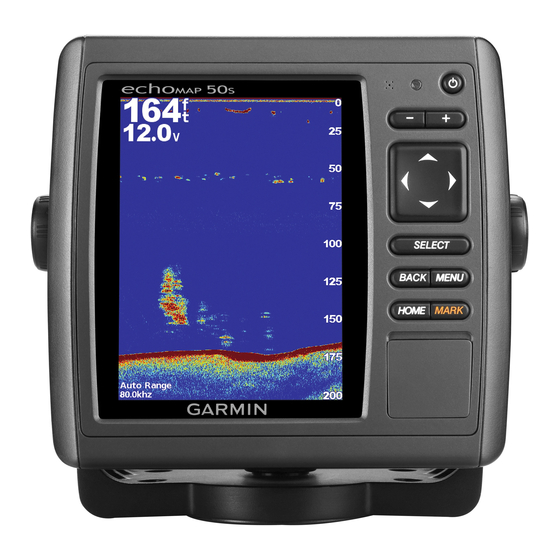Connecting a Wireless Device to the Chartplotter
Before you can connect a wireless device to the chartplotter
wireless network, you must configure the chartplotter wireless
network
(page
24).
You can connect a wireless device to the chartplotter to share
data. For example, you can connect an iOS ® device to the
chartplotter to share BlueChart Mobile data.
1
From the iOS device, select Settings > Wi-Fi.
2
Select the wireless network name you entered for the
chartplotter network
(page
3
Enter the password you entered when you set up the
chartplotter as a wireless network.
Setting Alarms
Navigation Alarms
Select Settings > Alarms > Navigation.
Arrival: Sets an alarm to sound when you are within a specified
distance or time from a turn or a destination.
Anchor Drag: Sets an alarm to sound when you exceed a
specified drift distance while anchored.
Off Course: Sets an alarm to sound when you are off course by
a specified distance.
System Alarms
Alarm Clock: Sets an alarm clock.
Device Voltage: Sets an alarm to sound when the battery
reaches a specified low voltage.
GPS Accuracy: Sets an alarm to sound when the GPS location
accuracy falls outside the user-defined value.
Setting the Fuel Alarm
Before you can set a fuel level alarm, a compatible fuel flow
sensor must be connected to the NMEA 2000 network.
You can set an alarm to sound when the total amount of
remaining onboard fuel reaches the level you specify.
1
Select Settings > Alarms > Fuel > Fuel Alarm > On.
2
Enter the remaining amount of fuel that triggers the alarm.
Setting Weather Alarms
Before you can set weather alarms, you must have a
compatible chartplotter connected to a weather device, such as
a GXM™ device, and have a valid weather subscription.
1
Select Settings > Alarms > Weather.
2
Turn on alarms for specific weather events.
Units Settings
Select Settings > Units.
System Units: Sets the unit format for the device.
Heading: Sets the direction references used in calculating
heading information. Auto Mag Var (automatic magnetic
variation) sets the magnetic declination for your location
automatically. True sets true north as the heading reference.
Grid sets grid north as the heading reference (000º). User
Mag Var allows you to enter the magnetic variation value
manually.
Position Format: Sets the position format in which a given
location reading appears. Do not change this setting unless
you are using a map or chart that specifies a different
position format.
Map Datum: Sets the coordinate system on which the map is
structured. Do not change this setting unless you are using a
map or chart that specifies a different map datum.
Pressure Reference Time: Sets the reference time used to
calculate the barometer trend. The trend is indicated in the
barometer field.
Device Configuration
24).
Time Format: Sets a 12-hour, 24-hour, or UTC time format.
Time Zone: Sets the time zone, or allows automatic selection
based on GPS location.
Navigation Settings
NOTE: Some settings and options require additional charts or
hardware.
Select Settings > Navigation.
Route Labels: Sets the type of labels shown with route turns on
the map.
Auto Guidance: Sets the measurements for the Safe Depth,
Safe Height, and Shoreline Distance, when you are using
some premium maps.
Turn Transition Activation: Sets the turn transition to be
calculated based on time or distance.
Turn Transition Time: Sets how many minutes before the turn
that you transition to it as the next leg, when Time is
selected for the Turn Transition Activation. You can raise
this value to help improve the accuracy of the autopilot when
navigating a route or an Auto Guidance line with many
frequent turns or at higher speeds. For straighter routes or
slower speeds, lowering this value can improve autopilot
accuracy.
Turn Transition Distance: Sets how far before the turn that
you transition to it as the next leg, when Distance is selected
for the Turn Transition Activation. You can raise this value
to help improve the accuracy of the autopilot when
navigating a route or an Auto Guidance line with many
frequent turns or at higher speeds. For straighter routes or
slower speeds, lowering this value can improve autopilot
accuracy.
Route Start: Selects a starting point for route navigation.
Auto Guidance Line Configurations
The Safe Depth and Safe Height settings influence how the
chartplotter calculates an Auto Guidance line. If an area has an
unknown water depth or an unknown obstacle height, the Auto
Guidance line is not calculated in that area. If an area at the
beginning or the end of an Auto Guidance line is shallower than
the safe water depth or lower than the safe obstacle height, the
Auto Guidance line is not calculated in that area. On the chart,
the course through those areas appears as a gray line. When
your boat enters one of those areas, a warning message
appears.
NOTE: Auto Guidance is available with premium charts, in
some areas.
You can set the parameters the chartplotter uses when
calculating an Auto Guidance line.
Safe Depth: Sets the minimum depth (chart depth datum) the
chartplotter uses when calculating an Auto Guidance line.
Safe Height: Sets the minimum height (chart height datum) of a
bridge that your boat can safely travel under.
Shoreline Distance: Sets how close to the shore you want the
Auto Guidance line to be placed. The Auto Guidance line
may move if you change this setting while navigating. The
available values for this setting are relative, not absolute. To
ensure that the Auto Guidance line is placed the appropriate
distance from shore, you can assess the placement of the
Auto Guidance line using one or more familiar destinations
that require navigation through a narrow waterway
(page
26).
CAUTION
25

